Santa Cruz Bicycles, a name synonymous with high-performance mountain bikes, has been quietly making waves in the drop-bar bike scene for nearly two decades. The Santa Cruz Stigmata, now in its impressive fourth generation, emerged from the early cyclocross craze in the US and has evolved into a leading contender in the gravel bike category long before “gravel” became the buzzword it is today.
Having previously reviewed the third-generation Santa Cruz Stigmata, I found it to be a solid, if somewhat understated, performer. It excelled as a sporty, road-bike-adjacent gravel machine, but its high price tag felt disconnected from the brand’s mountain bike DNA. It lacked a distinct Santa Cruz character.
Fast forward to the fourth generation Stigmata, launched a year ago, and the transformation is striking. This iteration boldly embraces its Santa Cruz heritage. Mirroring the trend of mountain bike brands venturing into gravel, it features suspension-corrected geometry, a longer reach frame designed for a short 70mm stem, a convenient down tube storage compartment, and a Universal Derailleur Hanger (UDH). Defying typical new bike marketing hype, it prioritizes ride quality and practicality over weight savings and aerodynamic claims. Cables are routed externally at the headset, stiffness is intentionally reduced, and weight is increased – all in the pursuit of a superior gravel riding experience.
After extensive testing of this new model, both with a RockShox Rudy suspension fork and the rigid Stigmata fork, I can confidently say this bike is anything but vanilla. It embodies the features and ride characteristics that should be at the forefront of any modern gravel bike design. In fact, the Santa Cruz Stigmata has become my new benchmark gravel bike, perfectly suited for diverse off-road adventures and the desire for straightforward bike ownership.
The Bottom Line: The Stigmata represents the future of off-road focused gravel bikes, and it’s a bike I wholeheartedly desire to own.
The Pros: Exceptional ride quality, premium construction, progressive geometry inspiring confidence on challenging terrain, generous tire clearance, comfortable reach and stack dimensions, user-friendly design without unnecessary complexities, and a robust feel.
The Cons: Geometry geared towards off-road riding might not be ideal for all-road cyclists, limited accessory mounting points, average weight, premium price point limiting its accessibility, a mud-collecting shelf behind the bottom bracket. The tested 10-44T XPLR gearing felt restrictive for the bike’s off-road capabilities (previous spec). Early models experienced bushing issues in the XPLR AXS dropper post.
Pricing: Frameset: US$2,700 / AU$4,500. Complete bikes start at US$4,000 / AU$6,000. The tested configuration: US$7,700 / AU$11,000.
Delving Deeper into the Stigmata
The Gen-4 Stigmata marks a significant departure from its predecessors, most notably in its progressive geometry.
Across all six frame sizes, the reach has been extended by a substantial 30mm, specifically optimized for use with a shorter 70mm stem. The head tube angle has been slackened by a full 2 degrees, settling at a consistent 69.5 degrees, resulting in a generous 87mm trail figure. These geometry adjustments strategically position the front wheel further forward, enhancing stability and eliminating toe overlap concerns. While these numbers aren’t groundbreaking, they closely mirror the geometry of the BMC URS, another off-road-oriented gravel bike that I previously praised.
| XS | S | M | L | XL | XXL | |
|---|---|---|---|---|---|---|
| Reach | 375 | 390 | 405 | 420 | 435 | 450 |
| Stack | 550 | 564 | 576 | 600 | 612 | 631 |
| Head Tube Angle | 69.5° | 69.5° | 69.5° | 69.5° | 69.5° | 69.5° |
| Seat Tube Length | 450 | 455 | 485 | 515 | 545 | 575 |
| Front Center | 605 | 625 | 645 | 668 | 688 | 710 |
| BB Drop | 78 | 78 | 76 | 76 | 74 | 74 |
| Wheelbase | 1023 | 1043 | 1063 | 1087 | 1108 | 1130 |
| Rear Center | 423 | 423 | 423 | 423 | 423 | 423 |
| Head Tube Length | 90 | 105 | 120 | 145 | 160 | 180 |
| Top Tube Length | 533 | 552 | 570 | 592 | 610 | 631 |
| Seat Tube Angle | 74° | 74° | 74° | 74° | 74° | 74° |
Gravel tire trends are leaning towards larger volumes, as evidenced by riders at Unbound 200 opting for the widest tires their bikes could accommodate. The Stigmata’s geometry is tailored around 700 x 45 mm tires, officially ending compatibility with smaller 650B wheels – a decision I personally applaud.
While 45mm is the maximum tire size for 2x drivetrains (up to 50/36T gearing), switching to a 1x setup unlocks clearance for up to 700 x 50 mm tires without compromising the frame’s classic aesthetics. Of course, narrower tires are also compatible, but be prepared for quicker handling and a lower bottom bracket.
The Stigmata’s geometry is also suspension-corrected, designed to work seamlessly with a 40 mm suspension gravel fork or Santa Cruz’s rigid Stigmata fork. Both forks share a 45 mm offset, and the rigid fork’s 430 mm axle-to-crown height mirrors the RockShox XPLR fork with its intended 5 mm of sag.
 Santa Cruz Stigmata suspension-corrected geometry for gravel riding
Santa Cruz Stigmata suspension-corrected geometry for gravel riding
Santa Cruz Bicycles is now part of the PON conglomerate, alongside brands like Cervelo, Cannondale, Focus, and GT. This affiliation is relevant because the Stigmata, with its extended front-center geometry, falls outside UCI gravel bike regulations, clearly positioning it towards the off-road end of the gravel spectrum. Conversely, bikes like the updated Cervelo Aspero prioritize road-like aesthetics and geometry. While the Aspero might seem like the go-to for gravel racing, the Stigmata boasts an impressive race pedigree, including a 2023 Unbound victory with Keegan Swenson, blurring the lines between race and off-road capability.
Being part of PON allows Santa Cruz to forge its own path, diverging from trends like headset-routed cables, press-fit bottom brackets, and proprietary seatposts. The Stigmata stands out as one of the most mechanic-friendly carbon gravel bikes available, backed by Santa Cruz’s renowned reputation for quality and a lifetime warranty.
Home mechanics will appreciate the three externally routed, internally sheathed cable ports at the side of the head tube, leaving the headset solely responsible for fork rotation. It features a standard 68 mm English threaded bottom bracket, a conventional 27.2 mm round seatpost with an external clamp, standard thru-axles, and flat mount brakes designed for 160 mm rotors (compatible with 180 mm rotors). The inclusion of a high-quality aluminum UDH derailleur hanger, rather than a typical composite version, is another testament to Santa Cruz’s commitment to durability.
 Santa Cruz Stigmata cable routing for easy maintenance
Santa Cruz Stigmata cable routing for easy maintenance
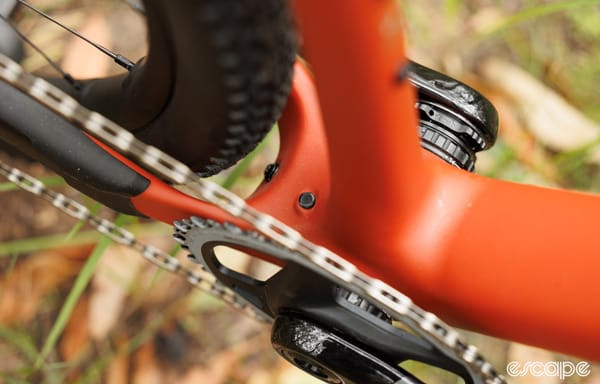 Santa Cruz Stigmata fender mounts and threaded bottom bracket for practicality
Santa Cruz Stigmata fender mounts and threaded bottom bracket for practicality
While some brands overload bikes with mounting points, the Stigmata adopts a minimalist and clean approach. Santa Cruz cites aesthetics and the added weight of reinforced carbon layups around mounting points as reasons for this design choice. It includes a third bottle mount under the down tube and subtle fender mounts, but otherwise relies on strap-on bags. For riders who prefer clean lines and use velcro-style bags, this minimalist approach will be welcomed.
However, the Stigmata does incorporate internal storage with its “Glove Box” – a down tube storage hatch similar to those found on Santa Cruz mountain bikes. A secure clip provides access to a well-sealed compartment, perfect for stashing essentials. Santa Cruz includes two high-quality neoprene wraps for organizing an inner tube and small items like a multi-tool and tire repair kit.
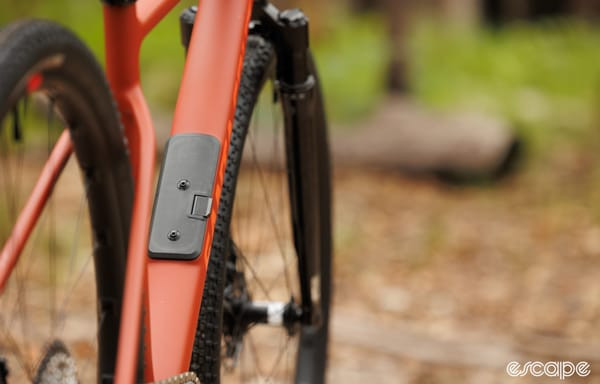 Santa Cruz Stigmata Glove Box down tube storage – clip to open
Santa Cruz Stigmata Glove Box down tube storage – clip to open
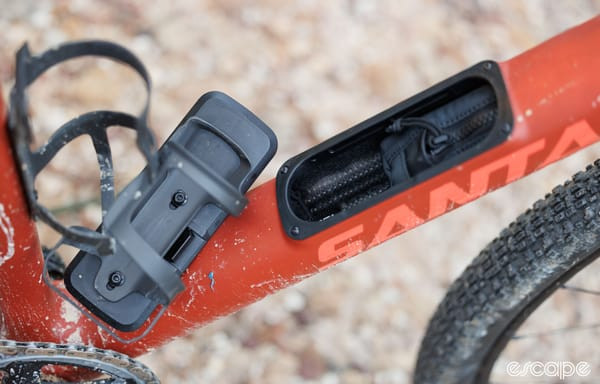 Santa Cruz Stigmata Glove Box internal storage compartment
Santa Cruz Stigmata Glove Box internal storage compartment
The longer, mountain bike-inspired geometry and the Glove Box contribute to a slightly heavier frame compared to the previous Stigmata generation. A Gen-3 56 cm Stigmata frame is claimed to weigh 1,260 grams, while a large Gen-4 Stigmata adds a claimed 120 grams. While not exceptionally lightweight for a premium carbon frame, Santa Cruz prioritizes durability and reliability. The test bike, equipped with a suspension fork, RockShox AXS dropper seatpost (heavy), and 700×45 mm tires, weighed 9.41 kg (20.75 lb) in a medium size. A lighter build with a rigid fork and carbon seatpost weighs approximately 8 kg (17.6 lb).
Stigmata Pricing and Configuration Options
Santa Cruz offers a single “premium” CC-grade carbon fiber frame for the Stigmata, available in six sizes, three colors (including two new options), and a range of recently updated build kits.
The Stigmata lineup includes options with SRAM 1x and a suspension fork, or 2x gearing with a rigid carbon fork (excluding the base model, which is 1x with a rigid fork). A frameset option is also available (US$2,700 / AU$4,500). The reviewed bike featured the previous top-end Force 1x AXS RSV build kit, now replaced by updated configurations.
Complete bikes with rigid forks start at US$4,000 / AU$6,000, featuring the new SRAM Apex Eagle 1×12 mechanical groupset (10-50T cassette) and reliable components. For US$4,999 / AU$7,700, the build significantly upgrades to a full SRAM Rival 2x AXS Wide groupset, Easton ARC/DT Swiss 370 alloy wheels, and a mix of Zipp, WTB, and Easton components, including a carbon fiber seatpost. The top-tier rigid-fork option at US$7,000 / AU$10,500 includes a SRAM Force 2x AXS Wide groupset (with the improved Red AXS shifters), Reserve 25|GR Carbon wheels with DT Swiss 350 hubs, and premium touchpoints.
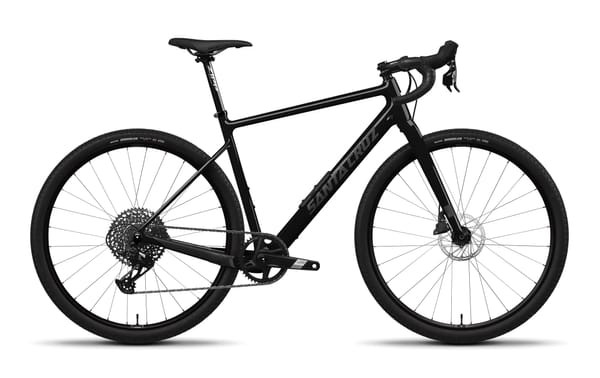 Santa Cruz Stigmata Apex 1x build kit for entry-level gravel
Santa Cruz Stigmata Apex 1x build kit for entry-level gravel
 Santa Cruz Stigmata Rival 1x AXS build kit in gloss purple
Santa Cruz Stigmata Rival 1x AXS build kit in gloss purple
Two complete bike options come stock with a Rockshox Rudy 40 mm suspension fork. The US$4,900 / AU$7,500 model features a RockShox Rudy Base XPLR suspension fork, a 1x SRAM Rival/GX Transmission Mullet AXS groupset (10-52T cassette), Easton ARC/DT 370 alloy wheels, and Zipp/Easton components. The premium suspension-equipped option (US$7,700 / AU$11,500) includes a RockShox Rudy Ultimate XPLR 40 mm fork, RockShox Reverb AXS XPLR dropper post, Reserve 25/GR carbon wheels, and a wide-range SRAM Mullet groupset combining the XO Eagle Transmission derailleur, Force AXS crank, and Red AXS shifters.
All Stigmata frameset and complete bike options utilize the same frame, allowing for customization and upgrades.
Enhanced Comfort and Confidence on the Stigmata
While many bikes prioritize stiffness, the Stigmata prioritizes rider comfort. From the first ride, the increased compliance of the new Stigmata was noticeable. It felt more forgiving and comfortable compared to the previous generation, both in and out of the saddle, thanks to Santa Cruz’s refined carbon fiber construction.
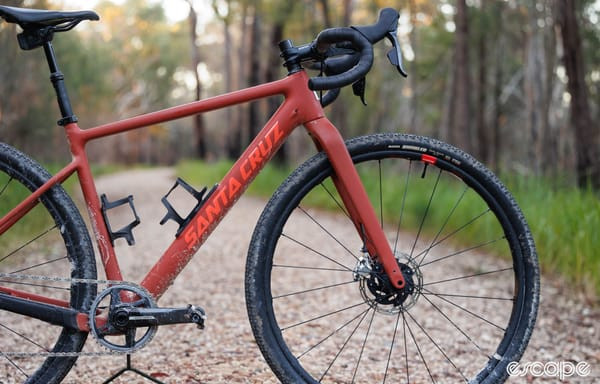 Santa Cruz Stigmata comfort-focused carbon frame design
Santa Cruz Stigmata comfort-focused carbon frame design
Santa Cruz confirmed this intentional focus on comfort. According to Josh Kissner, director of product, softening the ride quality, especially at the front end, was a key objective. The Gen-4 Stigmata employs size-specific stiffness targets, unlike the Gen-3 which had broader stiffness groupings. In a size large, bottom bracket and rear stiffness are reduced by approximately 10%, and lateral head tube stiffness is reduced by 12%. The Gen-4 fork also offers improved fore-aft compliance.
The generous tire clearance and standard component fitments allow for further customization to enhance comfort. Riders can opt for wider tires, more compliant handlebars, suspension stems, or flexible seatposts. The suspension fork option further contributes to a plush ride.
Despite the reduction in stiffness, the Stigmata retains responsiveness and doesn’t exhibit any unwanted handling quirks. It remains efficient under power, and while stiffer bikes exist, the Stigmata’s level of stiffness is more than sufficient for off-road riding.
The Stigmata’s handling is balanced and excels on rough and steep terrain. The longer front-center geometry, mirroring modern mountain bikes, positions the rider centrally, promoting confident front wheel weighting for enhanced traction in corners.
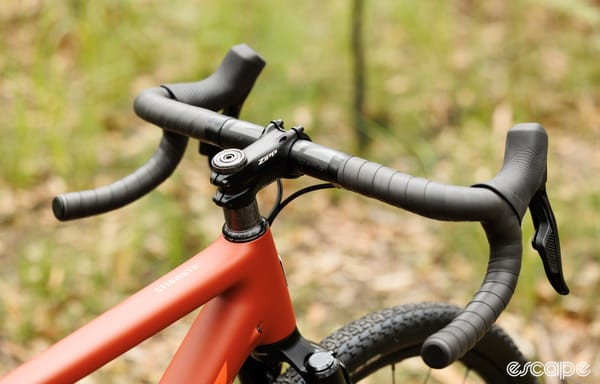 Santa Cruz Stigmata playful handling with long front-center and short stem
Santa Cruz Stigmata playful handling with long front-center and short stem
Santa Cruz maintains a consistent head angle and 87 mm trail figure across all frame sizes. This approach, combined with the long front-center, eliminates the need to adjust head angles or fork rake on smaller sizes to address toe overlap. Subtle variations in bottom bracket height across frame sizes accommodate different crank lengths and contribute to balanced handling as wheelbase increases.
Even with its suspension-corrected, taller front end, the Stigmata remains composed on steep climbs. The short stem keeps steering responsive, preventing the bike from feeling sluggish on smoother surfaces. The relatively low bottom bracket enhances stability and agility on tight trails. The Stigmata’s handling is stable, eager, and agile, demonstrating Santa Cruz’s mastery of modern gravel geometry.
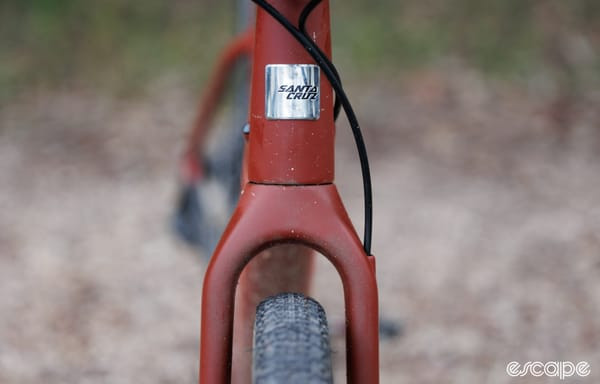 Santa Cruz Stigmata balanced and sporty feel despite increased fork length
Santa Cruz Stigmata balanced and sporty feel despite increased fork length
The Stigmata’s fit is welcoming, offering a comfortable position without being overly aggressive. The reach figure, based on a 70 mm stem, is crucial for sizing. A medium Stigmata with a 405 mm reach and 70 mm stem felt similar to a traditional dropbar bike with a 380 mm reach and 100 mm stem.
While the medium size felt well-balanced, the consistent 423 mm chainstay length across all sizes might lead to a less balanced feel on larger frames, potentially causing front-wheel lift on climbs for taller riders.
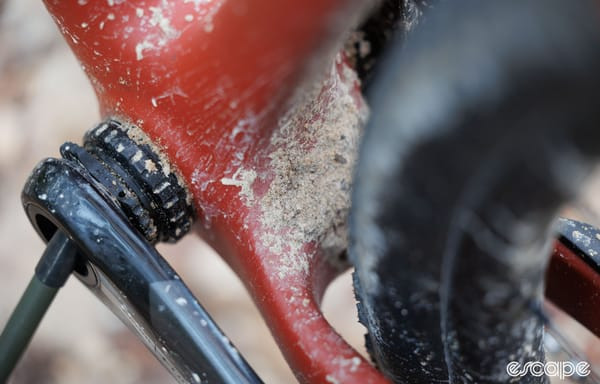 Santa Cruz Stigmata mud-collecting shelf behind bottom bracket
Santa Cruz Stigmata mud-collecting shelf behind bottom bracket
Rigid vs. Suspension Fork Options for the Stigmata
Initially skeptical of gravel suspension, my perspective shifted after testing the Stigmata with both rigid and suspension forks. While rigid forks were my default preference for gravel bikes, the RockShox Rudy Ultimate XPLR suspension fork proved to be a game-changer on this bike.
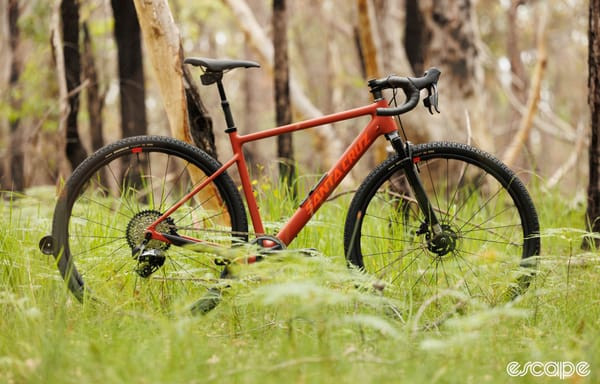 Santa Cruz Stigmata with suspension fork – aesthetically functional
Santa Cruz Stigmata with suspension fork – aesthetically functional
The Stigmata is inherently comfortable, but the suspension fork significantly enhances front-end compliance, creating a more balanced feel front to rear. Even with just 40 mm of travel, the suspension inspires confidence and allows the bike to tackle rough terrain at higher speeds.
The suspension fork noticeably reduced hand and wrist fatigue on prolonged rough rides. It also provided a speed advantage on bumpy terrain, keeping the front wheel planted and tracking smoothly where a rigid fork would transmit jarring feedback.
However, the RockShox Ultimate XPLR suspension fork isn’t universally ideal.
 Santa Cruz Stigmata with rigid fork
Santa Cruz Stigmata with rigid fork
For riders prioritizing off-road performance and exploring challenging terrain, the suspension fork is the superior choice. The comfort and speed benefits outweigh the weight penalty. The Stigmata’s geometry is designed to maximize the advantages of suspension.
For riders who split time between pavement and gravel, the rigid fork remains a viable option. It’s lighter, requires no maintenance, and is always “locked out.” While the XPLR suspension fork has a lockout, the lever isn’t user-friendly for frequent switching.
The weight difference is substantial. Santa Cruz’s rigid carbon fork weighs 438 g, while the RockShox Rudy Ultimate XPLR Suspension fork weighs 1,272 g – a difference of 834 g.
Ideally, owning both rigid and suspension forks for the Stigmata would allow for customization based on riding conditions. However, the rigid fork’s internal brake hose routing complicates fork swaps, requiring brake bleeding.
 Santa Cruz Stigmata fork swap complexity due to brake hose routing
Santa Cruz Stigmata fork swap complexity due to brake hose routing
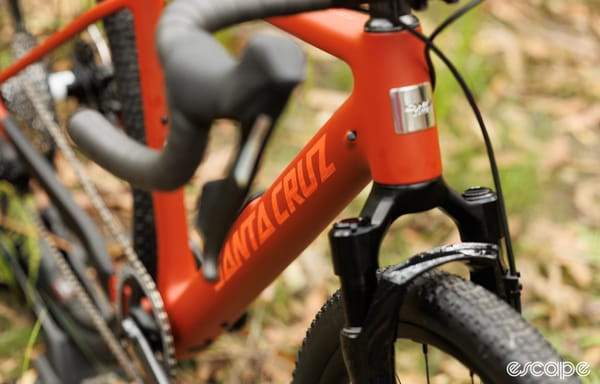 Santa Cruz Stigmata suspension fork lockout dial
Santa Cruz Stigmata suspension fork lockout dial
Build Kit Strengths and Weaknesses
While the Stigmata frame is exceptional, some aspects of the test bike’s build kit were less impressive. The 10-44T gearing range of the SRAM Force XPLR 1x groupset felt limiting for the bike’s off-road capabilities. A SRAM AXS “Mullet” setup with a wider-range 10-52T cassette would be more suitable, which Santa Cruz now offers in its updated high-end Stigmata build kits using Transmission derailleurs.
The RockShox Reverb AXS XPLR dropper seatpost is a standout component with excellent performance and intuitive AXS integration. Its 75 mm of drop is useful given the bike’s capability.
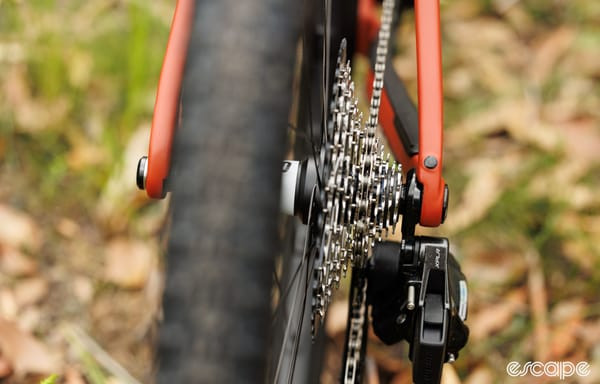 Santa Cruz Stigmata Force XPLR 1x 10-44T gearing – now updated to Mullet
Santa Cruz Stigmata Force XPLR 1x 10-44T gearing – now updated to Mullet
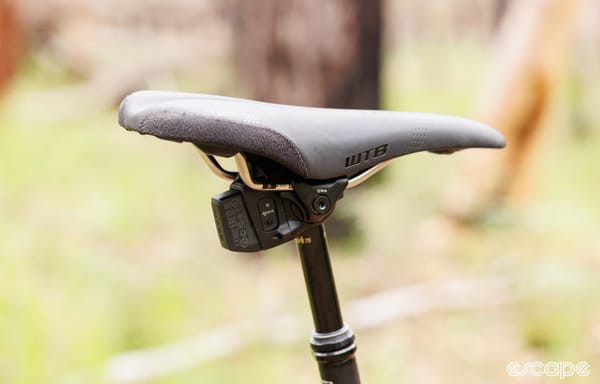 Santa Cruz Stigmata XPLR AXS dropper post with bushing play issue
Santa Cruz Stigmata XPLR AXS dropper post with bushing play issue
However, the AXS dropper post battery life was shorter than expected, requiring more frequent charging. The test post also developed bushing play, noticeable while pedaling and rattling on descents. While warranty-covered, it highlights the added maintenance of dropper posts.
The rest of the build kit is excellent. Reserve 25|GR carbon rims on DT Swiss 350 hubs offer a great balance of compliance and reliability. Maxxis Rambler 45 mm tires are versatile and highly rated. Santa Cruz uses quality Cane Creek headsets, Burgtec thru-axles, and brand-name touchpoints, demonstrating attention to detail.
 Santa Cruz Stigmata Reserve carbon wheels and Maxxis Rambler tires
Santa Cruz Stigmata Reserve carbon wheels and Maxxis Rambler tires
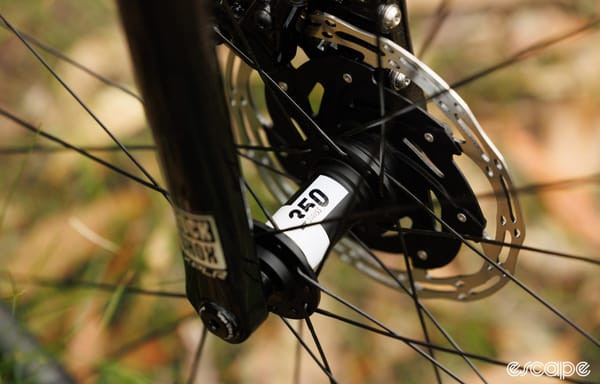 Santa Cruz Stigmata DT Swiss 350 hub – proven reliability
Santa Cruz Stigmata DT Swiss 350 hub – proven reliability
The Glove Box is a practical and rattle-free storage solution. It includes neoprene bags for organizing spares and tools, offering convenient access comparable to a saddlebag without the clutter. It’s particularly useful with dropper posts, which can interfere with saddlebag mounting. While weather-sealed, minor water ingress can occur in wet conditions, requiring occasional content checks.
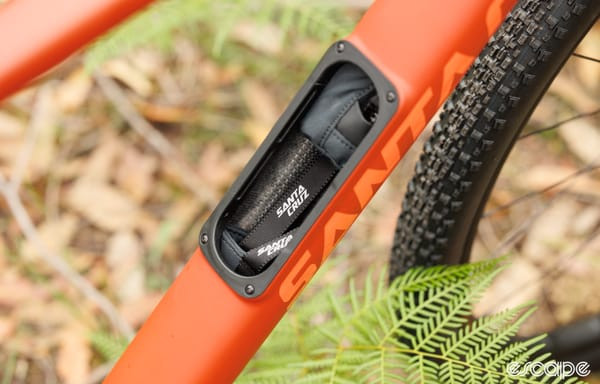 Santa Cruz Stigmata Glove Box hatch access
Santa Cruz Stigmata Glove Box hatch access
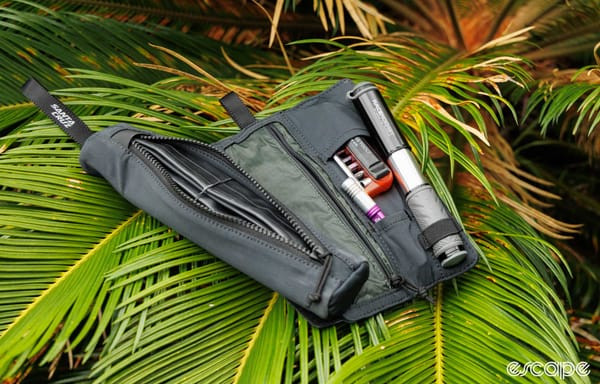 Santa Cruz Stigmata Glove Box included storage bags
Santa Cruz Stigmata Glove Box included storage bags
Final Verdict: The Santa Cruz Stigmata Gravel Bike
The Santa Cruz Stigmata excels as an off-road gravel bike, thriving on rough terrain. It’s ideal for riders who enjoy pushing the limits on gravel bikes and seeking “under-biking” experiences. It’s also a capable race bike for technical gravel courses.
For riders prioritizing smooth, fast gravel events or seeking a dual-purpose road and gravel bike, more road-oriented options might be better suited.
While not the cheapest or lightest, the Santa Cruz Stigmata delivers exceptional off-road performance and user-friendly design, solidifying its position as a top contender in the gravel bike market. It’s a testament to Santa Cruz’s commitment to quality and rider experience. The new Stigmata is far from vanilla and has become a benchmark gravel bike, earning my enthusiastic recommendation and personal desire to own one.
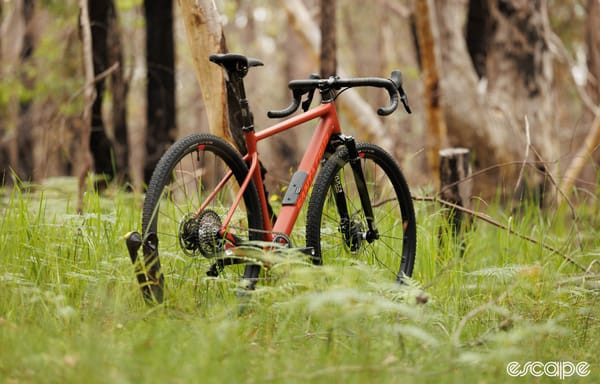 Santa Cruz Stigmata gravel bike action shot
Santa Cruz Stigmata gravel bike action shot Santa Cruz Stigmata comfort-focused carbon frame design
Santa Cruz Stigmata comfort-focused carbon frame design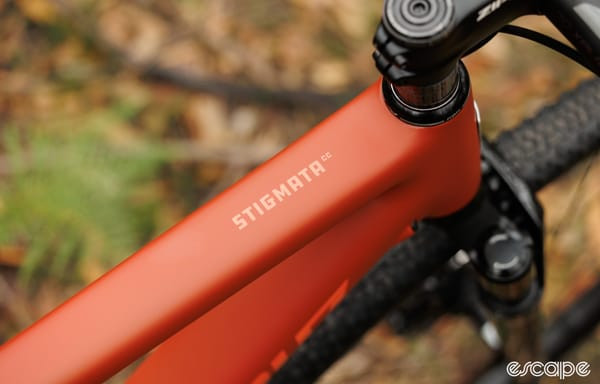 Santa Cruz Stigmata versatile gravel bike
Santa Cruz Stigmata versatile gravel bike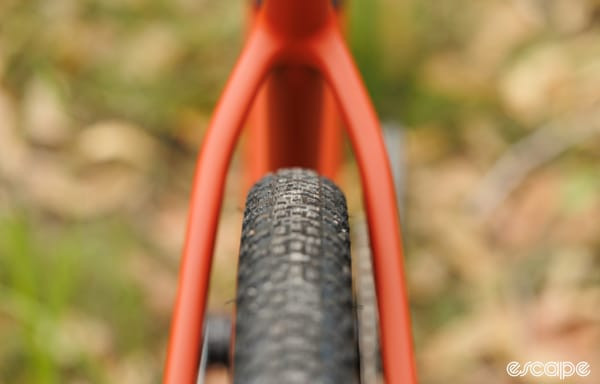 Santa Cruz Stigmata detail shot
Santa Cruz Stigmata detail shot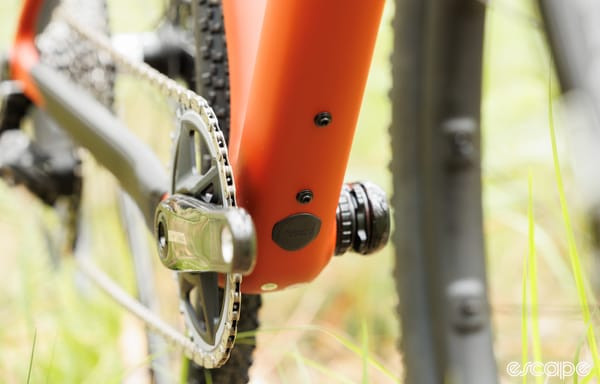 Santa Cruz Stigmata components detail
Santa Cruz Stigmata components detail Santa Cruz Stigmata riding in nature
Santa Cruz Stigmata riding in nature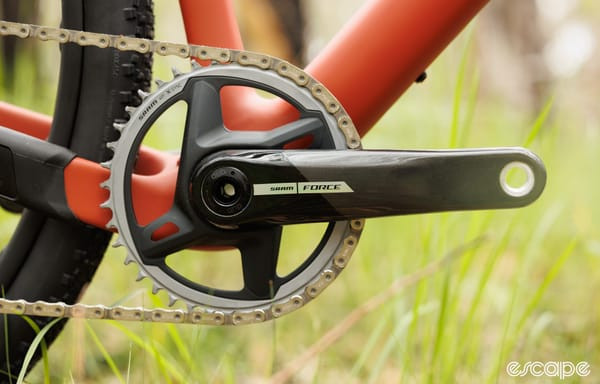 Santa Cruz Stigmata handling on gravel
Santa Cruz Stigmata handling on gravel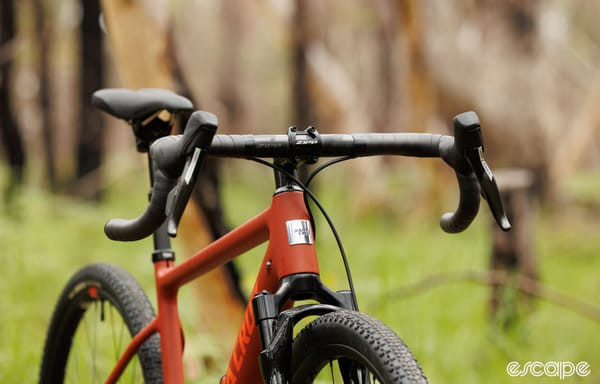 Santa Cruz Stigmata frame detail
Santa Cruz Stigmata frame detail
